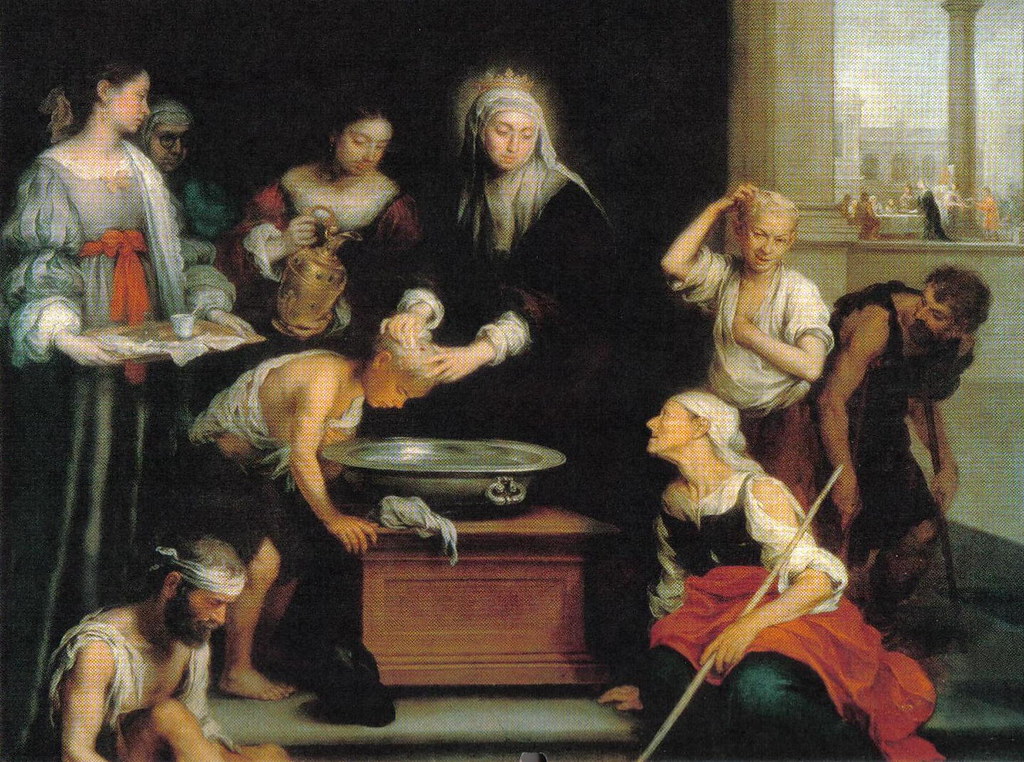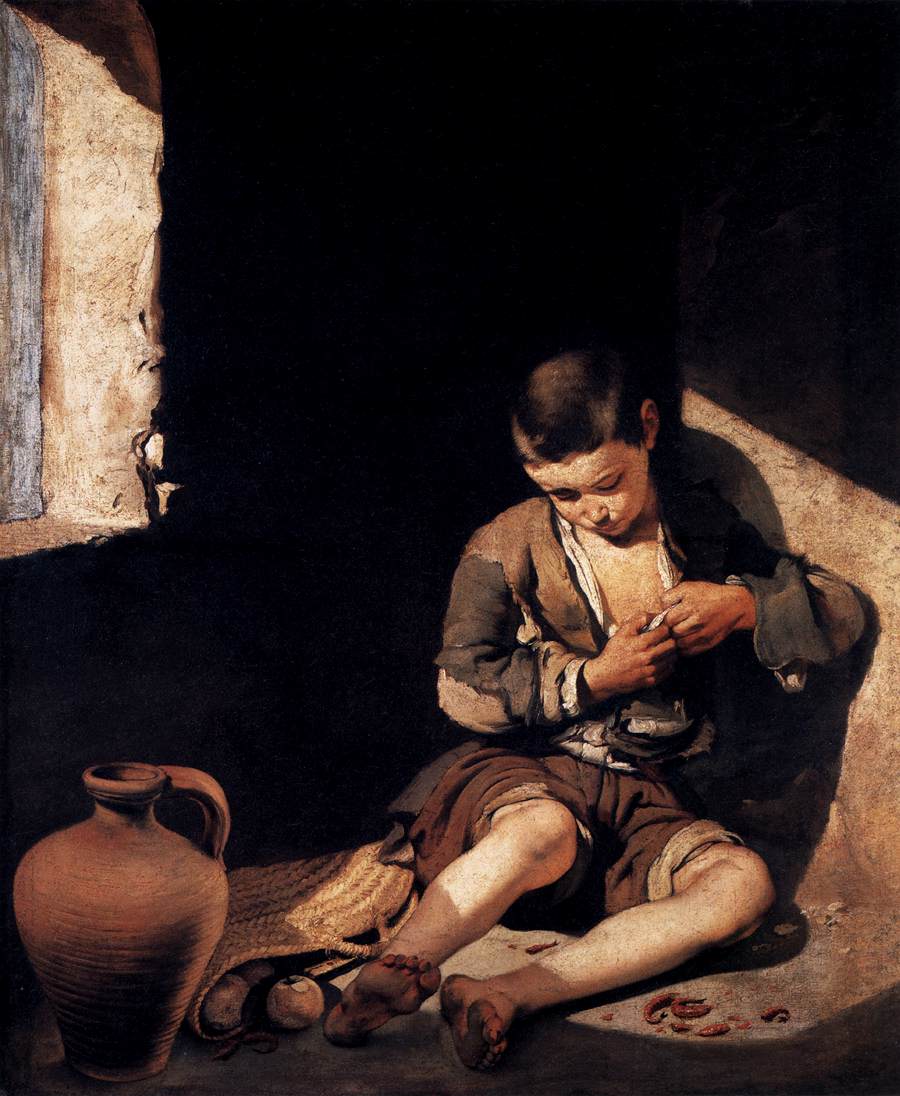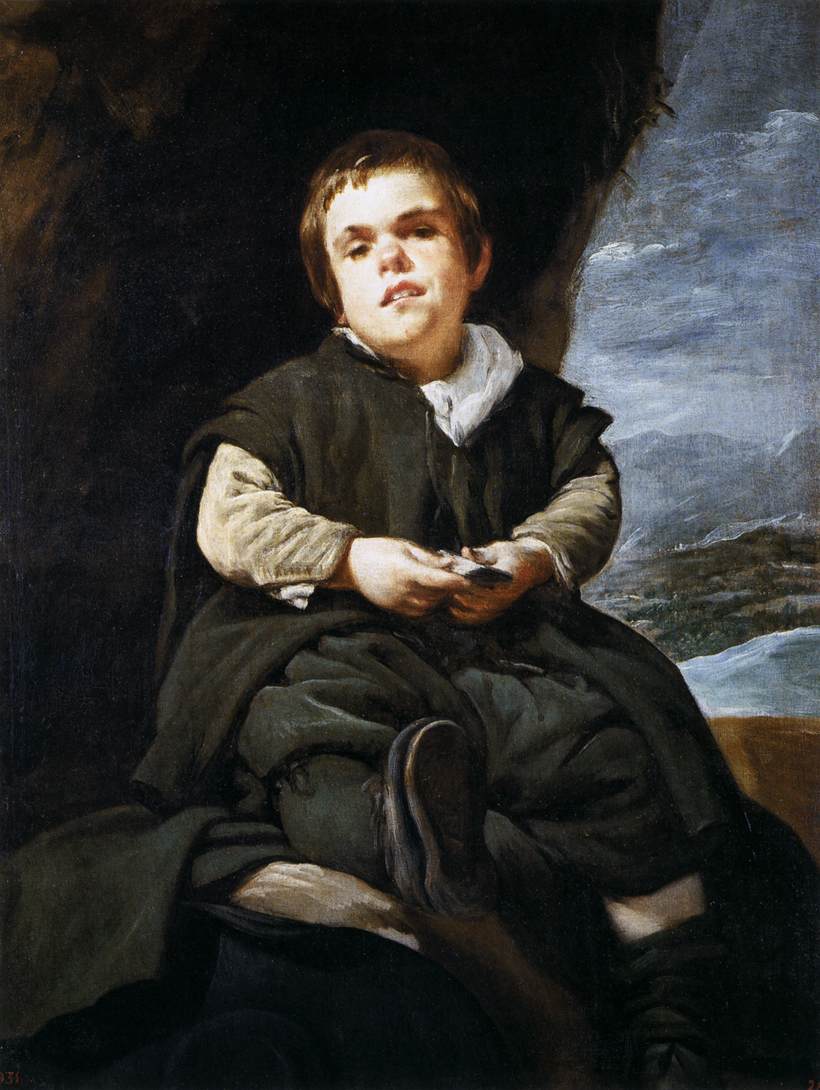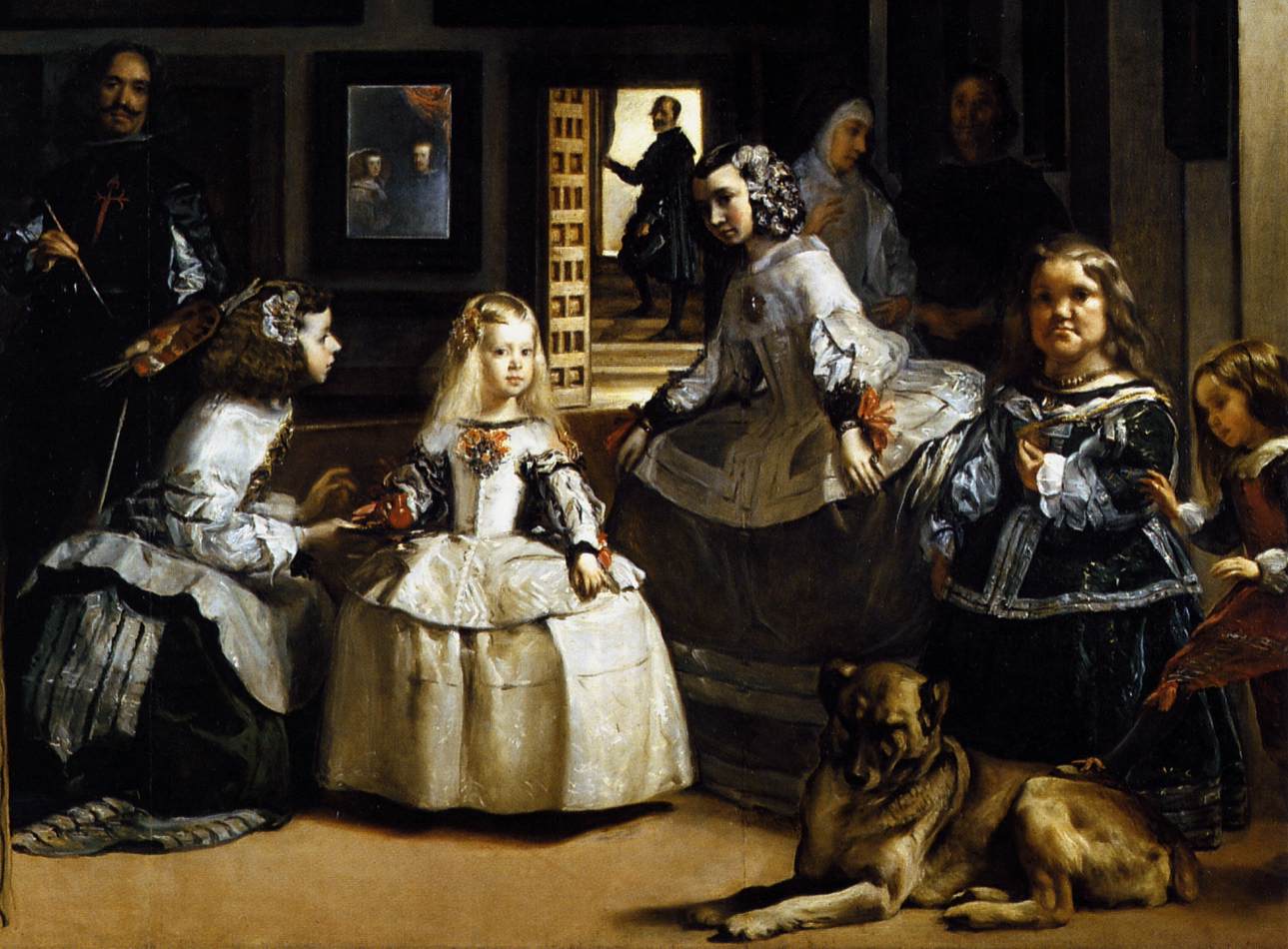.

Cup
of Water and a Rose on a Silver Plate: Francisco de Zurbarán
(1598-1664), c. 1630, oil on canvas, 21.2 x 30.1 cm (National Gallery,
London)
The painting of Seville (and we may put under this rubric those painters born in Seville, like Murillo and Valdés Leal, those who did their apprenticeship there, like Velásquez, and those who made their careers there, like Zurbarán) is wholly
contained within one century, the eighteenth, but its fruit is truly
that of the Hesperides. These painters who were lifted to the skies
by their individual lyricism or their pitiless realism are nonetheless
strongly Italianate: there is nothing in their work that had not already
occurred in the Venetians and in Caravaggio -- nothing except, naturally, the temperament and the inimitable accent. Their favorite subjects are characteristically Spanish insofar as
they testify to the choice of the artist or his Spanish patron in the
seventeenth century; nevertheless, they follow the main currents of
European Counter-Reformation art -- religious melodramas, portraits of aristocratic clients or men of the Church, and genre scenes or still lifes inspired by the art of the North. Yet, in Spanish religious painting, a fervor inherited from the Middle Ages still sustains those forms of male and female saints who are otherwise so pompously oratorical or voluptuously soft. In portraits, the Spanish painter individualizes where
the Italian painter personalizes: a great sixteenth-century Italian
portrait is a meditation on beauty, ambition, or the flight of youth, or
even on old age and guile, as in Titian's Paul III; however unique, these beings express more than themselves; they contain within themselves the
highest aspirations or most hidden vices of the race; they are fleeting
moments of an eternal theme. Here, in contrast, the profound
Christianity and dark realism of Spain come together to clothe with
tragic dignity and singularity that hunchback, that anemic Infanta, that vermin-ridden pauper, or that Knight of Calatrava, each marked with the individual
characteristics he will carry to the grave, enclosed within a body
through which he must seek damnation or salvation. Even in the greatest
-- Velásquez, for example, whose
genius seems to draw classical conclusions from this perpetual
confrontation of the moment with the object, lessons which we feel are
universal -- the meaning of those lessons remains a mystery to us for
lack of evidence, just as the inner secrets and raison d'être
of each individual we meet in life remain a mystery to us. No art is
more stripped of metaphysics than this art which is so nourished with
religious intentions: it is not death which is presented to us in that
picture of Valdés Leal which Murillo claimed reeked with stench; it is a cadaver, and the cadaver is a portrait. Murillo's Saint Elizabeth is not a symbol of charity: she is a woman washing a man suffering from scurvy. In Zurbarán's or Alonso Cano's pictures
of saints in ecstasy, we are not shown the beatific vision; we are
shown the look of the visionary. This obsession with the individual
marks the final victory of West over East, yet at the
same time baroque showiness eliminates the last traces of Arab or
Mudejar refinement. Moreover, whole areas of classical humanism will
continue to remain foreign in Spanish painting -- for example, the glory
of the nude. The Venus of Velásquez is a masterpiece that goes against the
current in this land dominated by Christian preconceptions and, more
clandestinely, by Oriental atavism, and also, perhaps, too obsessed with
detail, the accidental, and the momentary to take pleasure in the pure
melody of form. In contrast, the Maja desnuda of Goya, which is not at all Andalusian and would not have shocked a Sevillian cigar-maker, enters the tradition of realism
with its sensuous but ill-formed body. Even the swarthy, golden flesh
of Murillo's little beggars is inseparable from their rags, which seem a
part of their very being.
In genre scenes or still lifes, the Andalusian school asserts itself with this same typically Spanish realism -- and to give that word its full force one must perhaps include the dialectical
meaning it had in medieval philosophy. Not the Essence or the Idea, but
the Thing Itself. Not the dreamy meditation of a Rembrandt or a Soutine on the secrets of matter, not the almost mystical vision of a Vermeer or the formal, intellectual rearrangements of a Chardin or a Cézanne.
But the object itself -- that fish, that onion, that pink, that lemon
beside that orange. And perhaps it has not been sufficiently observed
that these powerful realist painters of the School of Seville represent only one point of view, extraordinarily intense, to be sure, but limited to certain almost obsessive aspects of Spain: the carefree languor of Seville is virtually absent.
Until Goya, who will sketch the beautiful strollers of Madrid (and the
ugly ones, too), or the hubbub of pilgrimages with the same clean line
with which he elsewhere notes down an
accident or a scuffle in some public square, Spanish painting had
rarely attempted to render freely life out-of-doors and in full
daylight. Flemish, Florentine, and Venetian painters, respectively, teach us far more about their sky and the air in their streets than the Sevillian painters of the Golden Age teach us about Seville.
Marguerite Yourcenar: from Andalusia, or the Hesperides, revised version of an essay originally titled Regard sur les Hespérides, as published in Cahiers du Sud 315 (1952); reprinted in Le temps, ce grand sculpteur, 1983; translated by Walter Kaiser in collaboration with the author in That Mighty Sculptor, Time, 1992

Still-life with Lemons, Oranges and Rose: Francisco de Zurbarán (1598-1664), 1633, oil on canvas, 107 X 60 cm (Norton Simon Museum of Art, Pasadena)
Still-life with Pottery Jars: Francisco de Zurbarán (1598-1664), c. 1630, oil on canvas, 84 x 46 cm (Museo del Prado, Madrid)

The Miracle at the Well: Alonso Cano (1601-1667), 1646-48, oil on canvas, 216 x 149 cm (Museo del Prado, Madrid)

St Elizabeth of Hungary Tending the Sick and the Leprous: Bartolomé Esteban Murillo (1617-1681), c. 1671-74, oil on canvas, 345 x 228 cm; image by folcoll (János), 1 December 2012 (Hospital de la Caridad, Seville)

The Young Beggar: Bartolomé Esteban Murillo (1617-1681), 1645-50, oil on canvas, 63 x 43 cm (Museo del Prado, Madrid)

Young Boys Playing Dice: Bartolomé Esteban Murillo (1617-1681), c. 1675, oil on canvas, 145 x 108 cm (Alte Pinakothek, Munich)

The Waterseller of Seville: Diego Rodriguez de Silva y Velázquez (1599-1660), 1623, oil on canvas, 106.7 x 81 cm (Wellington Museum, Apsley House, London)

The Dwarf Francisco Lezcano, Called "El Niño de Vallecas": Diego Rodriguez de Silva y Velázquez, 1643-45, oil on canvas, 107 x 83 cm (Museo del Prado, Madrid)

The Dwarf Don Juan Calabazas, called Calabacillas: Diego Rodriguez de Silva y Velázquez, 1637-39, oil on canvas, 106 x 83 cm (Museo del Prado, Madrid)

The Dwarf Sebastian de Morra: Diego Rodriguez de Silva y Velázquez, c. 1645, oil on canvas, 106.5 x 81.5 cm (Museo del Prado, Madrid)

Infanta Margarita: Diego Rodriguez de Silva y Velázquez (1599-1660), c. 1654, oil on canvas, 128.5 x 100 cm (Musée du Louvre, Paris)

Infanta Margarita (detail): Diego Rodriguez de Silva y Velázquez (1599-1660), c.1654 (Musée du Louvre, Paris)

Infanta Margarita: Diego Rodriguez de Silva y Velázquez (1599-1660), 1654-5, oil on canvas, 70 x 59 cm (Musée du Louvre, Paris)

Venus at her Mirror (The Rokeby Venus): Diego Rodriguez de Silva y Velázquez (1599-1660), 1649-51, oil on canvas, 177 x 122.5 cm (Museo del Prado, Madrid)

In Ictu Oculi: Juan de Valdés Leal (1622-1690), 1670-72, oil on canvas, 220 x 216 cm (Hospital de la Caridad, Seville)

Finis Gloriae Mundi: Juan de Valdés Leal (1622-1690), 1670-72, oil on canvas, 220 x 216 cm (Hospital de la Caridad, Seville)

Las Meniñas, or the family of Philip IV: Diego Rodriguez de Silva y Velázquez, 1656-1657, oil on canvas, 318 x 276 cm (Museo del Prado, Madrid)
I like the distinction between the Italian and the Spanish--
ReplyDeletethe Spanish painter individualizes where the Italian painter personalizes
though I'd have to think about that.
And what an interior world. No life out there in full daylight.
"Inimitable accent." I love the description of the paintings as well as the artwork.
Yourcenar's carefully measured sentences stand off from their subject to view it with a classical restraint that at the same time does not conceal the intensity of her involvement with this history:
ReplyDelete"...to clothe with tragic dignity and singularity that hunchback, that anemic Infanta, that vermin-ridden pauper, or that Knight of Calatrava, each marked with the individual characteristics he will carry to the grave, enclosed within a body through which he must seek damnation or salvation. Even in the greatest -- Velásquez, for example, whose genius seems to draw classical conclusions from this perpetual confrontation of the moment with the object, lessons which we feel are universal -- the meaning of those lessons remains a mystery to us for lack of evidence, just as the inner secrets and raison d'être of each individual we meet in life remain a mystery to us. No art is more stripped of metaphysics than this art which is so nourished with religious intentions..."
This is sober, exacting, illuminating commentary, expressed with a discriminating care for things that are lost. Yourcenar attended closely to this cultural past in the construction of two magisterial historical novels. The seriousness of her address to these matters is the opposite of dilettantism.
Catching the light, depicting the absence of light...
ReplyDeleteIt takes Masters.
Yes, Marie, the meditation on light and the absence of light was a great study of the seventeenth-century masters...
ReplyDelete"No art is more stripped of metaphysics than this art which is so nourished with religious intentions".
ReplyDeleteThere's a dialectic identified here that has meaning beyond the field of painting here, something that happens to bodies and intentions in the wake of the Reformation.
WB,
ReplyDeleteThanks for pointing to the gorilla in the room... who's wearing a gold crown over that splendid martyr's crown of thorns.
The control maintained by Yourcenar in this essay is close and exacting. What she doesn't discuss, but implies throughout, is a corollary economic and religious history. She had researched the period and location intensively during the long preparation of her novel about a wandering sixteenth century alchemist and freethinker, The Abyss. So she was quite aware that the art of the Sevillian School was the luxury product of a literal "Golden Age" -- that is, the time when the port of Seville commanded the entire economy of the Atlantic. The Guadalquivir was crowded with the great galleons, that legendary flotilla of the Indies returning from the Americas, groaning with loads of plundered silver and gold (and of course slaves as well). The wealth of the State was then the wealth of the town. And this was the latent defect in the Spanish imperial economy, that it was so dependent on the artificial wealth of a single great town -- "a controlled town," as Braudel put it, "rotten with dishonest officials and long dominated by foreign capitalists" -- and not on "a powerful free town capable of producing and carrying through a really individual economic policy". And beneath the gilded exterior there lay the sort of disorderly network of underworld activity that always feeds off (and supports) a great capitalist hub. One might think of the comparable case of New York in the twentieth century. These factors are inextricable from the history of artistic production. And at the same time, this was of course the period of the Inquisition -- in an essay on the language of the historical novel, Yourcenar has reproduced the harrowing documentary transcript of the torture of Campanella. Nothing metaphysical in that, of course. One might see the Counter-Reformation images of holy martyrdom as a convenient packaging of state terror. Indeed we ought to be familiar with that too, now -- though of course nobody would wish to connect the modern secular Cult of Capital with anything so uncomfortable as the Catholicism of the Spain of the Golden Age. By a half-century after the flourishing of the School of Seville, the bubble had burst, the base of trade had shifted from Seville to Cadiz. It was not till almost two centuries after the zenith of the Spanish Baroque that artists began tentatively to analyze its foundations. Thinking here of Goya -- with such chilling images as this 1812-1814 depiction of a procession of religious flagellants, which said so much that had before gone unsaid.
It seems that Goya link didn't work... trying again:
ReplyDeleteGoya: Procession of the Flagellants (1812-1814)